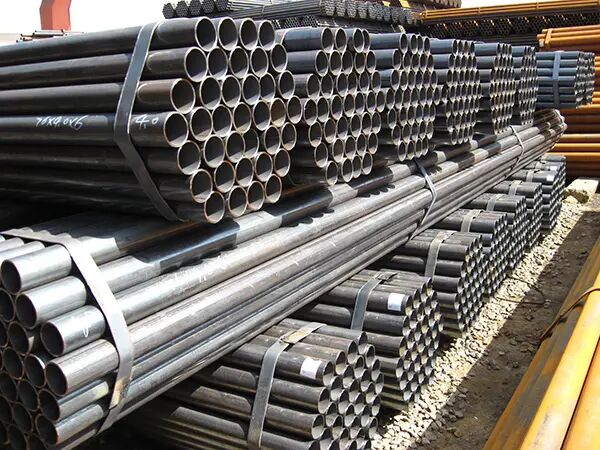With the increasingly strict requirements for pipeline performance and safety in the industrial field, ASTM International has formulated a series of technical specifications for carbon steel pipes covering different temperatures, pressures and applications. These specifications include A53 for the transportation of water and steam at normal temperatures, A106 for high-temperature equipment, A333 for low-temperature services, and A500 for structural purposes, etc., ensuring that the pipes comply with internationally recognized quality standards in terms of chemical composition, mechanical properties, dimensional tolerances and inspection methods. The following are several common
ASTM carbon steel pipe standards and their main contents:

ASTM A53/A53M - Black and galvanized carbon steel pipes (welded and seamless)
Scope of application: Black and hot-dip galvanized carbon steel pipes with nominal diameters ranging from NPS 1/8 to NPS 26 (DN 6 to DN 650) can be manufactured as welded (Type F, Type E) or seamless (Type S), with wall thickness as specified in the table.
Type and level
Type F (furnace welding or continuous welding, Grade A only)
Type E (resistance soldering, Grades A/B),
Type S (seamless, Grades A/B).
Performance requirements: Grade B minimum yield strength approximately 240 MPa, tensile strength approximately 415 MPa. It is suitable for mechanical and pressure pipelines, and is also often used for steam, water, air transportation and structural purposes.
ASTM A106/A106M - Seamless carbon steel tubes for High temperature service
Scope of application: Seamless carbon steel tubes specially designed for high-temperature services (such as boilers, heat exchangers, petrochemical equipment), with dimensions generally ranging from NPS 1/8 to NPS 48, and can be hot-formed or cold-drawn (NPS 1½ or less).
Grades: Grade A, Grade B, Grade C (each grade corresponds to different chemical compositions and high-temperature properties).
Typical properties: Grade B yield strength is approximately 240 MPa, tensile strength is about 415-550 MPa, and the maximum service temperature can reach over 400 °C.
ASTM A333/A333M - Carbon steel and low alloy steel pipes for Low temperature service
Scope of application: Welded or seamless tubes for low-temperature environments (typically up to -46 °C), nominal dimensions NPS 1/8 to NPS 48.
Grade and cold shock performance: Classified as Grades 1, 2, 3, etc. Different grades need to undergo charpy impact tests at specified low temperatures to ensure toughness.
Application scenarios: liquefied natural gas equipment, cryogenic storage tanks and pipelines.
ASTM A252/A252M - Welded pipe for pipe piles
Scope of application: Welded pipe piles, used for bearing the foundation of civil engineering, such as pile driving foundation, nominal size NPS 4 to NPS 24.
Grade: 1, 2, 3 (corresponding to different axial compressive and bending properties).
Features: Allows for larger dimensional tolerances and lower surface non-destructive testing requirements to reduce production costs and meet engineering load-bearing demands.
ASTM A500/A500M - Square, rectangular and round tubes for cold formed welded structures
Scope of application: Cold-rolled or cold-drawn square tubes, rectangular tubes and welded round tubes, used for building structures, Bridges and general structural purposes. The dimensions are determined according to the nominal pipe diameter or specification (e.g., 2"×2" square tubes).
Grades: Grade A (yield ≥ 210 MPa), Grade B (yield ≥ 247 MPa), Grade C (yield ≥ 290 MPa).
Performance requirements: High yield and tensile strength, as well as good formability are required.
ASTM A513 - Welded square, rectangular and round tubes for machinery
Scope of application: It is widely used in mechanical parts, automotive brackets and furniture, etc. The pipe material is required to have good processing and forming performance.
Grades: Type I (seamless cold drawing), Type II (seamless cold rolling), Type III (ERW), Type IV (electroslag remelting), Type V (straight seam welding).
Performance features: Strictly control the external dimensions, tolerances and surface quality, and it is usually not used as a pressure pipeline.
Summary
The ASTM carbon steel pipe standard covers a wide range of application scenarios, from normal temperature, low temperature, high temperature to structural and fire protection. When choosing the appropriate standard, the corresponding ASTM specification and grade should be determined based on the working temperature, pressure rating, dimensional tolerance, welding method and subsequent processing requirements. Only in this way can the safety, reliability and economy of the pipeline system during use be ensured.
Read more: ERW carbon steel pipe standards
